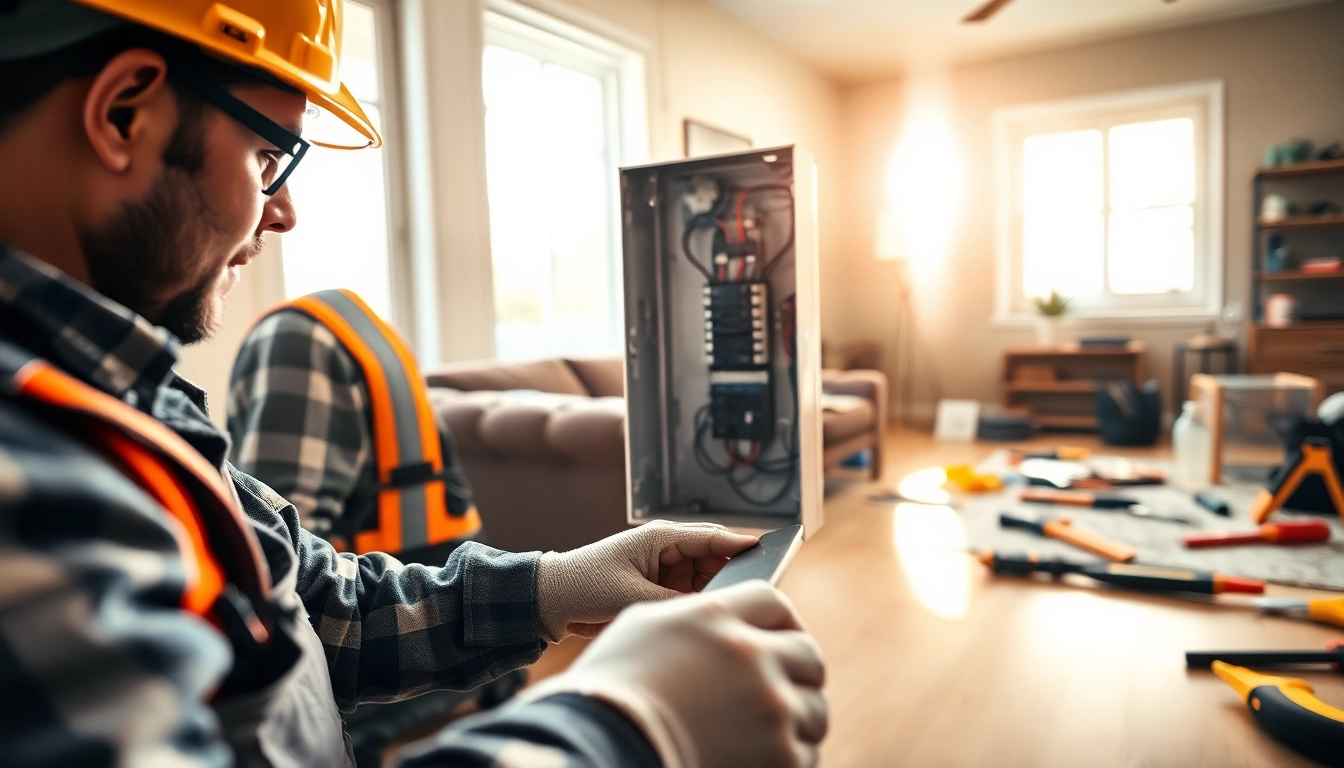Introduction to Electrical Panel Upgrade
Upgrading your electrical panel is not just a home improvement project; it’s an essential step toward ensuring the safety, efficiency, and functionality of your home’s electrical system. An electrical panel, often referred to as a breaker box, manages and distributes electrical energy throughout your residence, acting as the central hub for electricity. Given the increasing demand for power due to modern appliances and electronic devices, many homeowners find themselves questioning whether it’s time for an Electrical Panel Upgrade. This article explores the nuances of electrical panel upgrades, providing a comprehensive guide to recognizing the signs, understanding the benefits, estimating costs, and selecting the right professionals for the job.
What is an Electrical Panel?
An electrical panel is a key element in a home’s electrical system, serving as the point where electricity from the utility company enters your premises. It houses circuit breakers that protect your circuits from overloads and short circuits by interrupting the flow of electricity when necessary. In homes, electrical panels typically feature fuses or breakers rated for either 100, 150, or 200 amps. Understanding the specifications of your existing panel is crucial, especially as electrical requirements continue to grow with the proliferation of smart devices, high-efficiency appliances, and home improvement technologies.
When to Consider an Upgrade
Identifying the right time for an electrical panel upgrade can save homeowners from potential hazards associated with outdated systems. Key factors to consider include:
- Increased Electricity Demand: With the rise in usage of appliances like air conditioners, electric vehicles, and home offices, the existing panel may not supply enough power safely.
- Age of the Panel: Panels over 25 years old may not meet today’s safety standards and might require an upgrade.
- Frequent Breaker Trips: If you regularly experience tripped breakers, it may indicate that your panel can’t handle the load.
- Home Renovations: Adding new appliances or making significant changes to your home can necessitate a panel upgrade.
- Code Compliance: If you are looking to sell your home, ensuring an up-to-date panel may be required for compliance with local building codes.
Signs You Need an Upgrade
Homeowners should be aware of several tell-tale signs indicating the necessity for an electrical panel upgrade:
- Flickering Lights: This can indicate fluctuating voltages that may strain your electrical system.
- Burning Smells: Any burnt odors near the panel signal a serious electrical issue that must be addressed immediately.
- Surface Discoloration: Darkened areas around circuit breakers may indicate overheating, suggesting that your panel is not functioning efficiently.
- Insufficient Breaker Spaces: If your panel is filled with breakers, adding additional circuits will be problematic.
- Using Extension Cords and Power Strips: Reliance on extension cords for multiple electrical devices is a sign that your panel may not be supplying sufficient power.
Benefits of Upgrading Your Electrical Panel
Increased Capacity and Efficiency
One of the primary benefits of upgrading your electrical panel is the increased capacity to handle the energy demands of modern households. Most standard homes require a minimum of a 200 amp panel to support an array of appliances without overloading circuits. This increase in capacity not only improves efficiency but also reduces the likelihood of frequent breaker trips and power outages.
An upgraded panel also enables the integration of energy-efficient technologies, such as solar panels and electric vehicle (EV) chargers, adding long-term sustainability to energy consumption. With an increased amperage, the home can efficiently distribute energy across multiple devices, making life more convenient.
Enhanced Safety Measures
Safety is paramount in any electrical system. Old electrical panels may not incorporate modern safety features that new electrical panels offer, such as ground fault circuit interrupters (GFCIs) and arc fault circuit interrupters (AFCIs). These safety features help prevent electrical shocks and fires by shutting off power when they detect faulty electrical currents.
Additionally, upgrading can lead to better protection against electrical surges and overloads, making it a critical step for homeowners, especially those with older homes. Ensuring compliance with the latest electrical codes and regulations helps mitigate risks while increasing peace of mind.
Improved Home Value
A well-maintained electrical system adds value to your home. If you’re planning to sell, a newer, upgraded electrical panel is often appealing to potential buyers as it signifies that the property is safe and equipped to handle current electrical demands. Buyers typically seek out homes that won’t require immediate repairs, and having a modern panel is a significant selling point.
Furthermore, some insurance companies may provide discounts for homes with upgraded electrical systems, recognizing the reduced risks involved. Enhancing your property’s infrastructure goes beyond current use, setting it up for future resale and appreciation.
Costs Associated with an Electrical Panel Upgrade
Average Costs Explained
The cost of upgrading an electrical panel can vary significantly based on several factors, but homeowners should generally expect to pay between $800 and $4,000. Factors such as the type and size of the panel, local labor costs, and the complexity of the installation can all influence the final price.
A typical breakdown of costs includes:
- Labor Costs: Electricians typically charge between $50 and $120 per hour, so labor plays a substantial role in the overall cost.
- Panel Costs: Depending on the ampacity rating, panels range from $100 to $500 or more.
- Additional Materials: Other materials, permits, and inspections can add to the overall costs.
Factors Influencing the Price
Several elements can affect the price of an electrical panel upgrade:
- Location: Urban areas may have higher costs due to the cost of living and availability of professional services.
- Existing Wiring Conditions: If upgrades or repairs to the existing wiring are necessary, this will increase costs. Older homes may need significant updates to comply with modern codes.
- Type of Panel: Custom or specialized panels may incur additional costs beyond standard models.
- Permits and Inspections: Depending on local regulations, the process may require permits which can add to the initial expenses.
Is it Worth the Investment?
Determining whether an electrical panel upgrade is worth the investment requires considering both short-term needs and long-term benefits. While the upfront costs can be hefty, the advantages, such as improved safety, increased efficiency, enhanced home value, and compliance with electrical codes, make this upgrade a worthwhile consideration for many homeowners.
It’s crucial to think about the role of the electrical system in your quality of life. If your current system struggles to meet demands, investing in an upgrade can alleviate inconveniences that compromise safety and accessibility.
Choosing the Right Electrician for Your Upgrade
Key Qualifications to Look For
Choosing a qualified electrician is paramount for a successful panel upgrade. Key qualifications include:
- Licensing and Insurance: Ensure your electrician has the necessary licenses to operate in your state and carries adequate insurance to cover any mishaps.
- Experience: Look for professionals with a solid track record in panel upgrades and a thorough understanding of local codes.
- References and Reviews: Check reviews and ask for references from previous clients to gauge satisfaction and reliability.
Getting Multiple Quotes
Obtaining quotes from multiple electricians can provide insights into the typical costs for your specific project. Comparing quotes allows homeowners to assess the services offered, warranty provisions, and overall value on the scope of work. Remember, the lowest quote isn’t always the best; consider the reputation and experience of the contractor as well.
Understanding Warranties and Guarantees
When investing in an electrical panel upgrade, inquire about warranties for both the equipment and the installation work. Reputable electricians often provide guarantees on workmanship, and well-known manufacturers stand behind their products. Understanding these terms can protect your investment and ensure the longevity of your electrical system.
Conclusion: Making the Smart Choice for Your Home
Long-term Benefits of an Electrical Panel Upgrade
Ultimately, upgrading your electrical panel not only modernizes your home but also provides long-term benefits that enhance safety, efficiency, and property value. Homeowners should weigh the pros and cons carefully but recognize that a well-functioning electrical panel is essential for contemporary living.
Final Thoughts on Safety and Efficiency
Investments in electrical infrastructure are investments in safety. By ensuring that your panel can adequately meet current and future demands, you’re safeguarding your home and loved ones from potential electrical hazards.
Next Steps for Homeowners
For homeowners contemplating an electrical panel upgrade, the first step is to conduct a thorough assessment of their current system. It is advisable to seek professional advice to determine the specific needs and the optimal solutions for their particular situations. By following these guidelines and being proactive, you can ensure that your home remains safe, comfortable, and equipped for the demands of modern life.



